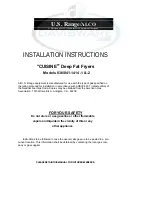
service pressure may fluctuate with local demand. External regulators are not required on the "Cuisine" fryer,
as that function is performed by a safety control valve.
The "Cuisine" Deep Fat Fryer can be installed to either natural or propane gas, depending on the
customer's ordering specifications. The correct safety control valve and orifices are installed at the factory for
the appropriate gas, and while the valve can be adjusted in the field, any adjustment should be made only by
qualified service personnel with the proper test eauipment.
Line pressure should be checked with a manometer; natural gas requires 5" WC and propane requires 10".
Rigid Connections
The fryer can be connected singly or as part of a cooking line. The connection into a cooking lin e was
outlined above. The stand-alone fryer (single or double tank) can be connected with an installer-supplied intake
pipe from the shut-off valve on the intake line to either side of the manifold pipe (cap the other end). Check any
installer-supplied intake pipe visually and/or blow them out with compressed air to clear dirt particles, threading
chips, or any other foreign matter before installing into a service line. Those particles will clog orifices when gas
pressure is applied.
All connections must be sealed with a joint compound suitable for LP gas, and all
connections must be tested with a soapy solution before lighting any pilots!
Flexible Couplings, Connectors , Casters
If the unit is to be installed with flexible couplings and/or quick-disconnect fittings, the installer must use
a heavy-duty, AGA design-certified commercial flexible connector of at least 1-1/4" NFT (with suitable strain
reliefs) in compliance with ANSI Z-21.69-1979. Domestic connectors are not suitable !
If the unit is to be installed with casters, the same ANSI Standard applies and, in addition, some means
must be found to limit the movement of the unit without relying on its associated piping or fittings.
Form CU-DFF 08/84






































